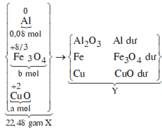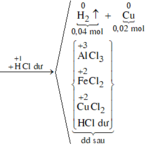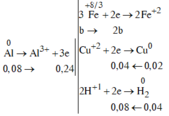Cho 5,6 gam sắt vào 800ml dung dịch axitclohidric 1M thu được muối sắtclorua và khí hidro. Hãy cho biết chất nào dư? Tính khối lượng dư?
Hãy nhập câu hỏi của bạn vào đây, nếu là tài khoản VIP, bạn sẽ được ưu tiên trả lời.

\(n_{Fe}=\dfrac{5,6}{56}=0,1\left(mol\right)\)
\(n_{HCl}=0,1.1=0,1\left(mol\right)\)
PTHH :
\(Fe+2HCl\rightarrow FeCl_2+H_2\)
Trc p/u: 0,1 0,1
p/u : 0,05 0,1 0,05 0,05
Sau p/u : 0,05 0 0,05 0,05
-> Fe dư sau p/u
a) \(m_{H_2}=0,05.2=0,1\left(g\right)\)
b) sau p/ư Fe dư
\(m_{Fedư}=0,05.2,8\left(g\right)\)
c) \(m_{FeCl_2}=0,05.\left(56+35,5.2\right)=6,35\left(g\right)\)

\(a)\\ Fe + 2HCl \to FeCl_2 + H_2\)
b)
\(n_{Fe} = \dfrac{22,4}{56}= 0,4(mol)\\ n_{H_2} = \dfrac{6,72}{22,4} = 0,3(mol)\)
Ta thấy : \(n_{Fe} > n_{H_2}\) nên Fe dư.
Theo PTHH :
\(n_{Fe\ pư} = n_{H_2} = 0,3(mol)\\ \Rightarrow m_{Fe\ pư} = 0,3.56 = 16,8(gam)\)
c)
Ta có :
\(n_{FeCl_2} = n_{H_2} = 0,3(mol)\\ \Rightarrow m_{FeCl_2} = 0,3.127 = 38,1(gam)\)

Ta có: nFe=5,656=0,1(mol)
nHCl=0,1.1=0,1(mol)
PT: Fe+2HCl→FeCl2+H2
Xét tỉ lệ: 0,11>0,12, ta được Fe dư.
a, Theo PT: nH2=12nHCl=0,05(mol)
⇒ VH2 = 0,05.22,4 = 1,12 (l)
PTHH: \(Fe+2HCl\rightarrow FeCl_2+H_2\uparrow\)
Ta có: \(\left\{{}\begin{matrix}n_{Fe}=\dfrac{5,6}{56}=0,1\left(mol\right)\\n_{HCl}=0,1\cdot1=0,1\left(mol\right)\end{matrix}\right.\)
Xét tỉ lệ: \(\dfrac{0,1}{1}>\dfrac{0,1}{2}\) \(\Rightarrow\) Sắt còn dư, HCl p/ứ hết
\(\Rightarrow n_{Fe\left(dư\right)}=0,05\left(mol\right)=n_{FeCl_2}\) \(\Rightarrow\left\{{}\begin{matrix}m_{Fe\left(dư\right)}=0,05\cdot56=2,8\left(g\right)\\C_{M_{FeCl_2}}=\dfrac{0,05}{0,1}=0,5\left(M\right)\end{matrix}\right.\)

400ml = 0,4l
\(n_{HCl}=1.0,4=0,4\left(mol\right)\)
a) Pt : \(Fe+2HCl\rightarrow FeCl_2+H_2|\)
1 2 1 1
0,2 0,4 0,2
b) \(n_{Fe}=\dfrac{0,4.1}{2}=0,2\left(mol\right)\)
⇒ \(m_{Fe}=0,2.56=11,2\left(g\right)\)
\(n_{H2}=\dfrac{0,4.1}{2}=0,2\left(mol\right)\)
\(V_{H2\left(dktc\right)}=0,2.22,4=4,48\left(l\right)\)
c) \(n_{CuO}=\dfrac{24}{80}=0,3\left(mol\right)\)
Pt ; \(H_2+CuO\underrightarrow{t^o}Cu+H_2O|\)
1 1 1 1
0,2 0,3 0,2
Lập tỉ số so sánh : \(\dfrac{0,2}{1}< \dfrac{0,3}{1}\)
⇒ H2 phản ứng hết , CuO dư
⇒ Tính toán dựa vào số mol của H2
\(n_{Cu}=\dfrac{0,2.1}{1}=0,2\left(mol\right)\)
⇒ \(m_{Cu}=0,2.64=12,8\left(g\right)\)
Chúc bạn học tốt
Em coi làm mấy bài hôm nay chưa làm nha, làm được nhiêu làm nè

\(Fe+2HCl\rightarrow FeCl_2+H_2\\ 0,2mol\text{:}0,4mol\rightarrow0,2mol\text{:}0,2mol\)
\(n_{Fe}=\dfrac{11,2}{56}=0,2\left(mol\right)\)
\(n_{HCl}=0,5.1=0,5\left(mol\right)\)
Ta có \(0,2< \dfrac{0,5}{2}\) nên HCl dư.
\(n_{HCldu}=0,5-0,4=0,1\left(mol\right)\)
\(m_{HCldu}=0,1.36,5=3,65\left(g\right)\)

*Xét giai đoạn Y tác dụng với dung dịch NaOH:
Số mol NaOH là: ![]()
Sơ đồ phản ứng:



*Xét giai đoạn Y tác dụng với dung dịch HCl dư
Số mol H2 thu được là: ![]()
Chất rắn Z là Cu ![]()
Chất rắn Z là Cu => Dung dịch sau không chứa F e 3 +
Sơ đồ phản ứng:



![]() => b = 0,06 mol
=> b = 0,06 mol
![]()
![]()
![]()


a)\(Fe+2HCl\rightarrow FeCl_2+H_2\)
\(n_{Fe}=\dfrac{5,6}{56}=0,1\left(mol\right)\)
\(n_{HCL}=0,1.1=0,1\left(mol\right)\)
\(\Rightarrow n_{H_2}=2nH_2=2,0,1=0,2\left(mol\right)\)
\(\Rightarrow V_{H_2}=0,2.22,4=4,48\left(ml\right)\)
b) sau pư Fe dư
ta có 1 molFe Pư 2 molHCL
0,05 molFe pư 0,1 HCL
\(\Rightarrow n_{Fe\left(dư\right)}:0,1-0,05=0,05\left(mol\right)\)
c)\(C_{MFeCL_2}=\dfrac{2.n_{HCL}}{0,1}=2M\)
\(n_{Fe}=\dfrac{5,6}{56}=0,1\left(mol\right)\)
800ml = 0,8l
\(n_{HCl}=1.0,8=0,8\left(mol\right)\)
Pt : \(Fe+2HCl\rightarrow FeCl_2+H_2|\)
1 2 1 1
0,1 0,8
Lập tỉ số so sánh : \(\dfrac{0,1}{1}< \dfrac{0,8}{2}\)
⇒ Fe phản ứng hết , HCl dư
⇒ Tính toán dựa vào số mol của Fe
\(n_{HCl\left(dư\right)}=0,8-\left(0,1.2\right)=0,6\left(mol\right)\)
⇒ \(m_{HCl\left(dư\right)}=0,6.36,5=21,9\left(g\right)\)
Chúc bạn học tốt
\(Fe + 2HCl \rightarrow FeCl_2 + H_2\)
\(n_{Fe}= \dfrac{5,6}{56}= 0,1 mol\)
\(n_{HCl}= 0,8 . 1 = 0,8 mol\)
\(Fe + 2HCl \rightarrow FeCl_2 + H_2\)
Trước pư: 0,1 0,8
PƯ: 0,1 0,2
Sau pư: 0 0,6
Sau pư, HCl dư 0,6 mol
\(m_{HCl dư}= 0,6 . 36,5= 21,9g\)